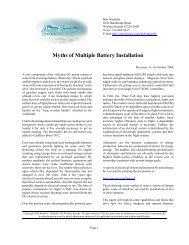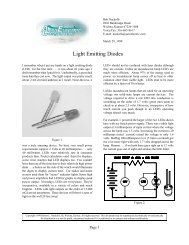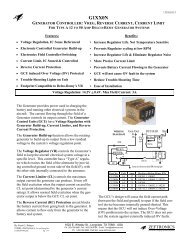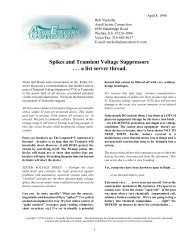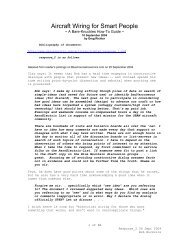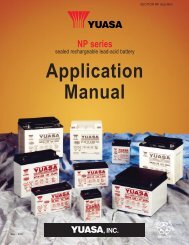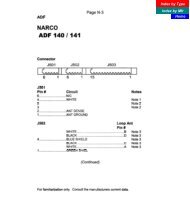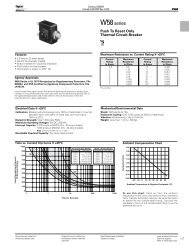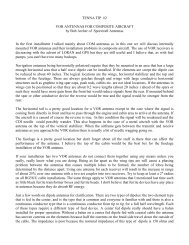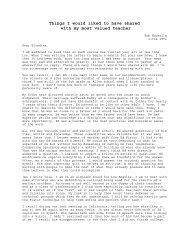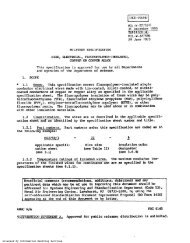Shower of Sparks Ignition - AeroElectric Connection
Shower of Sparks Ignition - AeroElectric Connection
Shower of Sparks Ignition - AeroElectric Connection
Create successful ePaper yourself
Turn your PDF publications into a flip-book with our unique Google optimized e-Paper software.
1<br />
<strong>AeroElectric</strong> <strong>Connection</strong><br />
6936 Bainbridge Road<br />
Wichita, KS 67226-1008<br />
htpp://www.aeroelectric.com<br />
20 November 2003<br />
<strong>Shower</strong> <strong>of</strong> <strong>Sparks</strong> <strong>Ignition</strong><br />
Preliminary Publication<br />
The topic <strong>of</strong> SOS ignition systems came up on the<br />
<strong>AeroElectric</strong>-List and I found this article I started back<br />
in ‘95 and for a variety <strong>of</strong> reasons, didn’t get<br />
completed. I’m making the article available in its<br />
present state along with a number <strong>of</strong> drawings. Please<br />
keep in mind that it needs some figures added and may<br />
have other errors.<br />
From time to time, a reader<br />
will call asking about<br />
replacing a "<strong>Shower</strong>-<strong>of</strong>-<strong>Sparks</strong>"<br />
(SOS) magneto with an impulse<br />
coupled magneto. When I ask<br />
why, the story <strong>of</strong>ten centers<br />
around the recommendation <strong>of</strong><br />
a mechanic or flying buddy.<br />
Seems that SOS systems are not<br />
highly regarded in some<br />
circles. A bit more conversation reveals that the person giving<br />
advice probably didn't understand how the system works and<br />
certainly didn't have a grasp on it's advantages.<br />
Let us consider the difference between impulse coupled and battery<br />
augmented, and SOS systems. While an engine is running, the<br />
two systems are indistinguishable from each other. A single set<br />
<strong>of</strong> points timed 20-30 degrees before top dead center delivers a<br />
spark to the appropriate cylinder via a magnetically charged<br />
transformer (inductor) and a distributor.<br />
Cranking the engine is a different situation. First, the engine<br />
is turning at about one tenth it's cruise RPM; a magneto's output<br />
voltage is firmly linked to the speed at which an internal magnet<br />
flies past a coil <strong>of</strong> wire. Cranking RPMs are not conducive to<br />
strong sparks from a magneto. Second, and VERY important, the<br />
spark must be retarded to some point at or past top-dead-center<br />
on piston travel. <strong>Ignition</strong> <strong>of</strong> an explosive mixture will drive the<br />
engine in the wrong direction producing the dreaded “kick back” .<br />
. . very hard on engines and accessories.<br />
With an impulse coupled magneto, a spring and cam mechanism locks<br />
the magneto drive shaft at some part <strong>of</strong> its rotation before the<br />
points would be opening to deliver an advanced spark to a running<br />
engine. As the engine moves forward, a spring in the coupler is<br />
wound against the locking mechanism until such time as a cam
causes it to be released. The spring unwinds quickly causing the<br />
magneto to "catch up" to the engine. By now, the engine has<br />
rotated 20 or so degrees further than normal cylinder firing<br />
time. The spring-driven shaft rapidly catching up with normal<br />
engine timing produces a short boost to the magneto’s<br />
instantaneous shaft velocity. The retarded release <strong>of</strong> the<br />
coupler’s mechanism allows the spark to occur much later in the<br />
engine’s rotation cycle. This relatively simple system overcomes<br />
the magneto's worst shortfall (no or poor spark at cranking RPM)<br />
and best yet, it works on simple airplanes with no starter or<br />
electrical system.<br />
An impulse-coupled sparks are not great sparks. Some engines<br />
(especially BIG ones) start poorly or not at all on the energy<br />
delivered to the plugs by an impulse coupled magneto. In days<br />
gone by, straight coupled mags were installed in tandem with a<br />
Kettering style, battery powered ignition system. A friend <strong>of</strong><br />
mine once owned a C-190 with a combination <strong>of</strong> straight coupled<br />
magneto and Kettering (pure battery-powered automotive) ignition<br />
systems. The engine started well using the battery ignition.<br />
The "secret" <strong>of</strong> an alternative magneto starting system is<br />
revealed in a Cub Scout merit badge project, a doorbell buzzer.<br />
Figure 1 illustrates an electro-magnet formed from a coil <strong>of</strong> wire<br />
positioned to so as to exert a magnetic tug upon an armature made<br />
<strong>of</strong> steel. In my Cub Scout project <strong>of</strong> many years gone by featured<br />
a coil wound on a bunch <strong>of</strong> finish nails clustered tightly<br />
together on a piece <strong>of</strong> pine. An “armature” fabricated from<br />
flashing metal is fitted with a spring hinge and electrical<br />
contacts in series with battery power to the coil.<br />
The “spring” tends to hold the contacts closed while a magnetic<br />
tug will force the contacts open. With the coil de-energized,<br />
contacts are closed and battery power flows into the coil. The<br />
resulting magnetic field pulls on the armature and opens the<br />
contacts, interrupting current to the coil. The cycle rapidly<br />
repeats emitting a buzzing sound in the process. Audible buzzing<br />
was a mechanical manifestation <strong>of</strong> the physics involved but a<br />
curious, more silent phenomenon occurs at the same time. Voltage<br />
induced in a wire is directly proportional to the speed at which<br />
a magnetic field builds or drops close proximity to the wire.<br />
Obviously, as the buzzer contacts open, the circuit is broken and<br />
the magnetic field collapses very quickly inducing a short<br />
"spike" <strong>of</strong> voltage in the buzzer coil <strong>of</strong> up to 100 volts or more!<br />
Many an unwary Cub Scout (including yours truly) was surprised to<br />
fine that his little flightlight battery powered physics<br />
demonstration could bite!<br />
Recalling the days <strong>of</strong> hand cranked, Model T Fords the ignition<br />
"coil" was a wooden box which contained a s<strong>of</strong>t iron transformer<br />
core wound with a few turns <strong>of</strong> heavy wire as a "primary" and lots<br />
2
<strong>of</strong> turns <strong>of</strong> fine wire as the "secondary". A relay armature and<br />
set <strong>of</strong> points were fitted to the end <strong>of</strong> the box were the<br />
transformer core protruded through. Normally closed points on the<br />
relay armature would be opened when the armature was attracted by<br />
electromagnetism in the transformer core. The points were hooked<br />
in series with the primary winding.<br />
When battery voltage was applied, the contacts would open when<br />
the primary current built up thus breaking the supply current and<br />
allowing primary current to fall quickly to zero. Of course, this<br />
allowed the points to re-close allowing the cycle to repeat.<br />
Sound familiar? As long as voltage were applied, the coil would<br />
"buzz". Each break in primary current allowed a rapid fall in<br />
magnetic field current which generated a voltage in the secondary<br />
<strong>of</strong> several thousands <strong>of</strong> volts - plenty <strong>of</strong> snort for lighting a<br />
gasoline fire. The operative features <strong>of</strong> this quaint automotive<br />
ignition <strong>of</strong>fered a solution to hard starting aircraft engines<br />
some decades later.<br />
Figure 2 illustrates a schematic representation <strong>of</strong> the magneto.<br />
Lacking battery power, a permanent magnet rotated by the engine<br />
is used to induce a magnetic field in the transformer core. The<br />
new wrinkle in this case is provided by a cam operated switch,<br />
commonly called "points". When closed, the points place a dead<br />
short on the transformer's primary winding. The short effectively<br />
pours molasses in the path <strong>of</strong> a magnetic field which is otherwise<br />
free to build and fall. Rapid field fluctuations are prevented as<br />
long as the points are closed. The points are opened by a cam<br />
driven in proper synchronization with engine rotation so as to<br />
provide a single spark at the right time. Early on we<br />
acknowledged the magneto's poor performance as an ignition source<br />
for starting. At cranking speeds, output voltage is small and<br />
unless fitted with some sort <strong>of</strong> delay mechanism (impulse couple)<br />
the spark will occur well before top dead center causing the<br />
dreaded “kick-back". Indeed, many early motorists suffered damage<br />
to body parts after failing to retard the spark control on the<br />
steering column before attempting to start the engine with a hand<br />
crank.<br />
Figure 3 illustrates a combination <strong>of</strong> all the points discussed so<br />
far. Suppose we fabricated a low voltage buzzer powered from the<br />
ship's battery. Instead <strong>of</strong> grounding the buzzer to airframe,<br />
let's connect it to the magneto points via the standard "p-lead"<br />
connection. Further, let's add a second set <strong>of</strong> points timed to<br />
open after the engine's pistons pass through top dead center. The<br />
second, retarded set <strong>of</strong> points are simply wired in parallel with<br />
the normal, advanced set. Now, if battery voltage is applied to<br />
this circuit, the "buzzer" will commence to do its thing,<br />
inducing a current in the circuit that rises and falls several<br />
hundred times per second. While either set <strong>of</strong> points is closed,<br />
the buzzer's effects are not felt by the magneto coil windings.<br />
3
Indeed, even after the normal or "advanced" points open, the<br />
retarded points are still closed. Only after both sets <strong>of</strong> points<br />
open, does the rapidly modulated buzzer current get applied to<br />
the magneto's primary winding. Now, each time the buzzer contacts<br />
close, current flowing in the magneto primary "charges" the coil.<br />
As the buzzer's contacts open, current drops to zero allowing<br />
rapid collapse <strong>of</strong> any previously established magnetic field. Just<br />
as in early automotive “buzz box” ignition systems (and later<br />
Kettering point-and-coil ignition systems), A high voltage pulse<br />
is induced in the secondary. When conducted to the proper plug by<br />
a distributor rotor and if conditions are right, the mixture in<br />
the cylinder ignites and the engine starts.<br />
Now, here's the best part. The first spark arrived at or near top<br />
dead center <strong>of</strong> piston travel when cylinder pressures are highest.<br />
If the first spark doesn't achieve ignition, another is sure to<br />
follow a few milliseconds later when pressures are lower. Plugs<br />
are easier to fire as cylinder pressures drop. It should be<br />
obvious now that unlike the impulse coupled magneto or even a<br />
Kettering points-and-coil ignition system, an SOS system <strong>of</strong>fers a<br />
series <strong>of</strong> sparks affording many chances for a cylinder to light<br />
<strong>of</strong>f for each transition through compression.<br />
Admittedly, the later the fire lights, the weaker will be the<br />
resulting explosion but, a WEAK explosion is much better than NO<br />
explosion. Given that SOS ignition performance is not pegged to<br />
rotational velocity <strong>of</strong> the magneto shaft, cranking speed is no<br />
longer critical. Ever watch an old aviation movie wherein some<br />
very large engines are started by pushing a prop by hand through<br />
a single blade? That engine was fitted with one-hell-<strong>of</strong>-an impulse<br />
coupled mag OR a shower <strong>of</strong> sparks ignition system.<br />
Figures x and x illustrate typical wiring for two <strong>Shower</strong>-<strong>of</strong>-<br />
<strong>Sparks</strong> applications. The first is typical <strong>of</strong> single engine<br />
airplanes with OFF-LEFT-RIGHT-BOTH-START key switches. This type<br />
<strong>of</strong> ignition switch can be fitted with an extra function which<br />
parallels the retard points with normal points in the "start"<br />
position. This terminal is generally labeled "LR" on the back <strong>of</strong><br />
the switch. Another function connects battery power to the buzzer<br />
(commonly called a "vibrator") only during a start. This terminal<br />
is generally labeled "BO". A little study <strong>of</strong> the switch functions<br />
chart and associated wiring will reveal the interplay <strong>of</strong> battery<br />
power, vibrator, and retard points in orchestrating what has to<br />
be the most effective starting scenario for magneto fitted<br />
engines.<br />
Light twins don't use key switches so a different approach is<br />
called for. SOS vibrators for twins have an additional relay<br />
included for the purpose <strong>of</strong> managing the special connections<br />
required for starting. In this case, voltage applied to the<br />
4
starter solenoid also energizes the SOS relay to apply voltage to<br />
the vibrator and connect the retard points in parallel with the<br />
advance points during cranking. The more expensive, relay fitted<br />
vibrator can be made to service a single engine airplane with<br />
appropriate key switch functions. However, the simpler,<br />
relay-less vibrator cannot be used on a light twin without adding<br />
an outboard relay or using a special function toggle switch to<br />
handle the extra switching duties.<br />
It should be obvious by now that a properly functioning SOS<br />
ignition system has VERY desirable qualities. Since there ain't<br />
no such thing as a free lunch, we'd better touch on the down-side<br />
<strong>of</strong> SOS ignition. First, if you think "kick-back" from a worn<br />
impulse couple is bad, wait 'til you crank an engine with worn or<br />
disconnected retard points in an SOS system! Further an airplane<br />
fitted with SOS magneto cannot be started by hand since the SOS<br />
system is battery powered and effective only while the cockpit<br />
controls are in the start position.<br />
In cases were a battery is too low to actually crank the engine,<br />
it might very well have enough energy to power the SOS vibrator.<br />
A starter disable switch would allow the SOS vibrator and retard<br />
points to be made active without energizing the starter. When the<br />
man on the prop yells “contact” and hears the vibrator buzzing<br />
away on the firewall, a gentle nudge <strong>of</strong> the propeller through<br />
top-dead-center will light ‘er <strong>of</strong>f. Another suggestion is to make<br />
provisions for a small, aux battery to power the SOS system<br />
through special "hand propping" circuitry in lieu <strong>of</strong> taking power<br />
from the main ship's battery.<br />
Given that few mechanics really understand the words you've just<br />
read, it behooves you to have a plan <strong>of</strong> action when your SOS<br />
system fails to deliver its usually sterling performance.<br />
Symptom: Engine cranks and starts and runs but dies on left mag<br />
only.<br />
Your left mag advance points may be unhooked. The engine will<br />
start on the retard points and run on the right mag when the<br />
switch is released to BOTH. Check the mag's advance points and<br />
associated wiring.<br />
Symptom: Engine fires and kicks back.<br />
DON'T GO ANY FURTHER until retard points, ignition switch, relay<br />
and/ or associated wiring is checked out. An SOS system with open<br />
retard points circuit is capable <strong>of</strong> precipitating severe starter<br />
and/or engine damage. Obviously, attempting to hand prop this<br />
engine could cost some fingers too . . . .<br />
5
Symptom: Engine starts but runs very poorly on left mag only.<br />
This would be a symptom <strong>of</strong> a stuck relay in a light twin SOS<br />
system . . . retard points are always hooked in causing left mag<br />
spark to be always very late.<br />
Symptom: Engine cranks but fails to show any indication <strong>of</strong><br />
ignition.<br />
Can you hear the vibrator buzzing? If you can't hear it normally,<br />
try disconnecting the small wire from your starter solenoid so<br />
that the engine stays quiet when you place the switch in START<br />
position. While in the START position, the vibrator should be<br />
audible. If your vibrator is fitted with an internal relay, an<br />
audible "click" should be heard before the "buzz" starts. If no<br />
"buzz" is present, check wiring paths marked x, x, and x in<br />
Figures z and z.<br />
Also, the CONDENSER could be shorted. The easiest way to check<br />
the condenser is to see if the magneto timing can be checked with<br />
a timing light. A shorted capacitor prevents the timing light<br />
from illuminating at any time.<br />
Conclusion:<br />
If it were MY airplane and I had an opportunity to choose between<br />
impulse coupled and SOS magneto, I'd readily prefer the SOS<br />
system. An SOS system gets an engine started like no other<br />
magneto can. It's a bit more complicated electrically but much<br />
simpler mechanically than its impulse coupled cousin. Virtually<br />
all <strong>of</strong> it's failure modes can be trouble shot without pulling the<br />
magneto from the engine. All ya gotta do is understand how it<br />
works . . . . .<br />
6


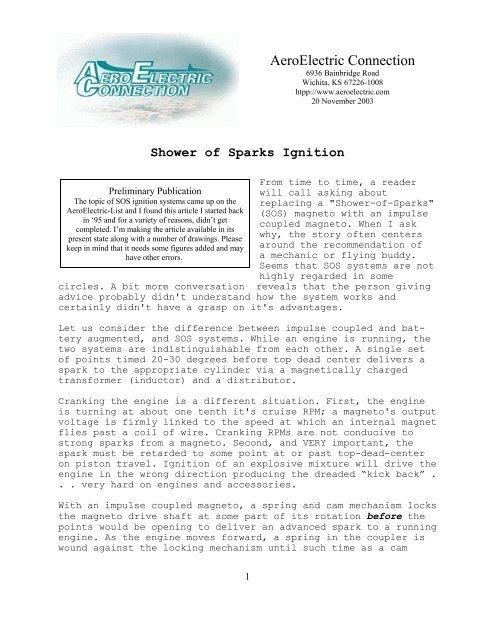
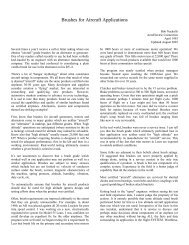
![G-Series-Ext [pdf] - Carling Technologies](https://img.yumpu.com/50918301/1/190x245/g-series-ext-pdf-carling-technologies.jpg?quality=85)

